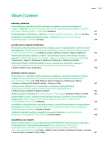Percutaneous endoscopic gastrostomy: analysis of practice at the endoscopic center of tertiary medical care
Authors:
Karel Balihar; Eva Janská; Lucie Zdrhová; Jan Kotyza; Václav Hejda; Jana Koželuhová
Authors‘ workplace:
Oddělení gastroenterologie a hepatologie I. interní kliniky LF UK a FN Plzeň
Published in:
Vnitř Lék 2016; 62(6): 435-441
Category:
Original Contributions
Overview
Introduction:
Percutaneous endoscopic gastrostomy (PEG) is a minimally invasive routine procedure used to provide long-term enteral nutrition in selected patients with impaired oral intake. The knowledge of clinical, technical and safety features of PEG is an important issue in clinical practice.
The aim of this study was to evaluate the population of patients selected for PEG insertion, describe certain aspects of the insertion procedure, assess the service life of PEG, as well as account for the number of complications and patient mortality in the six-month period following the procedure.
Methods:
We used a retrospective analysis of data from medical database. The data were collected in a single endoscopic tertiary-referral center for a period of seven and a half years.
Results:
We evaluated 326 PEG insertions performed on 292 patients with a median age of 63 years (IQR 55–70). Mortality in the six-month period following PEG insertion was 26 %. Prevailing indications for PEG insertion were oncological (53 %) and neurological (40 %) diseases, with certain fluctuation of these numbers during the observed period according to changing demands of the two medical specialties. Local anesthesia alone was applied in 56 % of patients, 38 % underwent analgosedation and 6 % required general anesthesia. Median duration of the procedure (from insertion of endoscope to its final extraction) in 68 consecutive procedures was 6 minutes (IQR 5–8). Median interval between PEG introduction and its first replacement in 21 patients was 22 months (IQR 14–31, range 4–76). 61 patients underwent PEG extraction during the observed period, 66 % of whom had oncological disease. Periprocedural complications were seen in 5.8 % of patients, of these one patient (0.3 %) suffered a serious complication. The buried bumper syndrome was observed in four patients (1.2 %), all of whom had neurological disease.
Conclusions:
PEG is a relatively safe procedure and can be performed in a short time using local anesthesia or analgosedation in a majority of patients. The population of patients indicated for PEG insertion reflects primarily the current needs of neurological and oncological departments. Most patients within the observed group benefit from PEG insertion for more than six months.
Key words:
analgosedation – complications – mortality – percutaneous endoscopic gastrostomy
Sources
1. Gauderer MW, Ponsky JL, Izant RJ Jr. Gastrostomy without laparotomy: a percutaneous endoscopic technique. J Pediatr Surg 1980; 15(6): 872–875.
2. Ho CS, Yee AC, McPherson R. Complications of surgical and percutaneous nonendoscopic gastrostomy: review of 233 patients. Gastroenterology 1988; 95(5): 1206–1210.
3. Mekhail TM, Adelstein DJ, Rybicki LA et al. Enteral nutrition during the treatment of head and neck carcinoma: is a percutaneous endoscopic gastrostomy tube preferable to a nasogastric tube? Cancer 2001; 91(9): 1785–1790.
4. Rimon E, Kagansky N, Levy S. Percutaneous endoscopic gastrostomy; evidence of different prognosis in various patient subgroups. Age Ageing 2005; 34(4): 353–357.
5. Zakova A, Munzova H, Kunovska M et al. Percutaneous endoscopic gastrostomy in nutritional therapy – personal experience. Vnitř Lék 1997; 43(4): 204–207.
6. Lee C, Im JP, Kim JW et al. Risk factors for complications and mortality of percutaneous endoscopic gastrostomy: a multicenter, retrospective study. Surg Endosc 2013; 27(10): 3806–3815.
7. Gundogan K, Yurci A, Coskun R et al. Outcomes of percutaneous endoscopic gastrostomy in hospitalized patients at a tertiary care center in Turkey. Eur J Clin Nutr 2014; 68(4): 437–440.
8. Cortes-Flores AO, Alvarez-Villasenor AS, Fuentes-Orozco C et al. Long-term outcome after percutaneous endoscopic gastrostomy in geriatric Mexican patients. Geriatr Gerontol Int 2015; 15(1): 19–26.
9. Koulentaki M, Reynolds N, Steinke D et al. Eight years‘ experience of gastrostomy tube management. Endoscopy 2002; 34(12): 941–945.
10. Biswas S, Dontukurthy S, Rosenzweig MG et al. Buried bumper syndrome revisited: a rare but potentially fatal complication of PEG tube placement. Case Rep Crit Care 2014; 2014: 634953. Dostupné z DOI: http://dx.doi.org/10.1155/2014/634953.
11. Lee TH, Lin JT. Clinical manifestations and management of buried bumper syndrome in patients with percutaneous endoscopic gastrostomy. Gastrointest Endosc 2008; 68(3): 580–584.
12. Ermis F, Ozel M, Oncu K et al. Indications, complications and long-term follow-up of patients undergoing percutaneous endoscopic gastrostomy: A retrospective study. Wien Klin Wochenschr 2012; 124(5–6): 148–153.
Labels
Diabetology Endocrinology Internal medicineArticle was published in
Internal Medicine

2016 Issue 6
Most read in this issue
- Sinus histiocytosis with massive lymphadenopathy: FDG-PET/CT documented partial remission after treatment with 2-chlorodeoxyadenosine
- Insulin application techniques in adult patients with diabetes
- Cardiomyopathy in MR image
- Percutaneous endoscopic gastrostomy: analysis of practice at the endoscopic center of tertiary medical care
